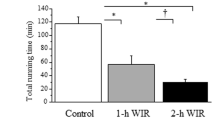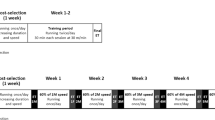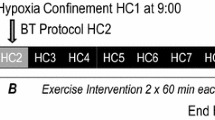Abstract
Chronic exercise conditioning has been shown to alter basal thermoregulatory processes as well as the response to inflammatory agents. Two such agents, lipopolysaccharide (LPS) and turpentine (TPT) are inducers of fever in rats. LPS, given intraperitoneally (i.p.), involves a systemic inflammatory response whereas TPT given intramuscularly (i.m.) elicits a localized inflammation. We assessed if chronic exercise training in the rat would alter the thermoregulatory response to LPS and TPT. Core temperature (T c) and motor activity were monitored by radiotelemetry. Female Sprague Dawley rats were divided into two groups (trained and sedentary) and housed at an ambient temperature of 22°C. Animals voluntarily trained on running wheels for 8 weeks. In the first study, trained and sedentary female rats were injected i.p. with LPS (50 μg/kg) or an equal volume of 0.9% normal saline. In another study, trained and sedentary female rats were injected i.m. with TPT (10 μl)/rat or an equal volume of 0.9% normal saline. The time course of the LPS fever was very short compared to TPT. TPT injected animals displayed a smaller but more prolonged fever compared to LPS; however, training accentuated the febrile response to LPS (ΔT c=0.6°C in sedentary and 1.2°C in trained). Training had a slight suppression on TPT-induced fever during the daytime but had no effect on motor activity or nighttime T c. In contrast, exercise training led to a marked increase in the pyrogenic effects of LPS. We conclude that the effect of exercise training and source of infection (i.e., systemic versus localized in muscle) on fever is directly linked to type of pyrogenic agent.





Similar content being viewed by others
References
Cannon JG, Kluger MJ (1983) Endogenous pyrogen activity in human plasma after exercise. Science 220:617–619
Cannon JG, Tompkins RG, Gelfland JA, Michie HR, Stanford GG, van der Meer JW, Endres S, Lonnemann G, Corsetti J, Chernow B (1990) Circulating interleukin-1 and tumor necrosis factor in septic shock and experimental endotoxin fever. J Infect Dis 161:79–84
Cartmell T, Poole S, Turnbull AV, Rothwell NJ, Luheshi GN (2000) Circulating interleukin-6 mediates the febrile response to localized inflammation in rats. J Physiol 525(3):653–661
Conn CA, Borer KT, Kluger MJ (1990) Body temperature rhythm and response to pyrogen in exercising and sedentary hamsters. Med Sci Sports Exerc 22(5):636–642
Cooper KW, Brouwer S, Turnbull AV, Luheshi GN, Hopkins SJ, Kunkel SL, Rothwell NJ (1994) Tumor necrosis factor-α and fever after peripheral inflammation in the rat. Am J Physiol 267:R1431–R1436
Gordon CJ, Rowsey PJ (1998) Delayed febrile effects of chlorpyrifos: is there cross-tolerance to bacterial lipopolysaccharide? Toxicology 130(1):17–28
Gordon CJ (1994) Thermoregulation in laboratory mammals and humans exposed to antichlolinesterase agents. Neurotoxicol Teratol 16:427–453
Klir JJ, McClellan JL, Kluger MJ (1994) Interleukin-1β causes the increase in anterior hypothalamic interleukin-6 during LPS-induced fever in rats. Am J Physiol 266:R1845–R1848
Leon LR (2002) Molecular biology of thermoregulation (Invited Review): cytokine regulation of fever: studies using gene knockout mice. J Appl Physiol 92:2648–2655
Luheshi GN, Miller AJ, Brouwer S, Dascombe MJ, Rothwell NJ, Hopkins SJ (1996) Interleukin-1 receptor antagonist inhibits endotoxin fever and systemic interleukin-6 induction in the rat. Am J Physiol 270:E91–E95
Luheshi GN, Stefferl A, Turnbull AV, Dascombe MJ, Brouwer S, Hopkins SJ, Rothwell NJ (1997) Febrile response to tissue inflammation involves both peripheral and brain IL-1 and TNF-α in the rat. Am J Physiol 272:R862–R868
Michie HR, Manogue KR, Spriggs DR, Revhaug A, ODwyer S, Dinarello CA, Cerami A, Wolff SM, Wilmore DW (1988) Detection of circulating tumor necrosis factor after endotoxin administration. N Engl J Med 318(23):1481–1486
Nara M, Kanda T, Tsukui S, Inukai T, Shimomura Y, Inoue S, Kobayashi I (1999) Running exercise increases tumor necrosis factor-alpha secreting from mesenteric fat in insulin-resistant rats. Life Sci 65(3):237–244
Ostrowski K, Rhode T, Asp S, Schjerling P, Pedersen BK (1999) Pro- and anti-inflammatory cytokine balance in strenuous exercise in humans. J Physiol (Lond) 515:287–291
Ostrowski K, Rohde T, Zacho M, Asp S, Pedersen BK (1998) Evidence that IL-6 is produced in human skeletal muscle during prolonged running. J Physiol (Lond) 508:949–953
Pedersen BK (2000) Special feature for the Olympic: effects of exercise on the immune system: exercise and cytokines. Immunol Cell Biol 78:532–535
Pedersen BK, Toft AD (2000) Effects of exercise on lymphocytes and cytokines. Br J Sports Med 34:246–251
Rowsey PJ, Kluger MJ (1994) Corticotropin releasing factor is involved in exercise-induced elevation in core temperature. Psychoneuroendocrinology 19:179–187
Rowsey PJ, Borer KT, Kluger MJ (1993a) Role of prostaglandin in exercise-induced core temperature elevation in female Sprague-Dawley rats. Am J Physiol 265:R1121–R1125
Rowsey PJ, Borer KT, Kluger MJ (1993b) Tumor necrosis factor is not involved in the exercise-induced core temperature elevation in female Sprague-Dawley rats. Am J Physiol 265:R1351–R1354
Rowsey PJ, Metzger BL, Carlson J, Gordon CJ (2003) Effects of exercise conditioning on thermoregulatory responses to repeated administration of chlorpyrifos. Environ Res 92:27–34
Rowsey PJ, Metzger BL, Gordon CJ (2001) Effects of exercise conditioning on thermoregulatory response to anticholinesterase insecticide toxicity. Biol Res Nurs 2(4):267–276
Satinoff E, Kent S, Hurd M (1991) Elevated body temperature in female rats after exercise. Med Sci Sports Exerc 23:1250–1253
Sprenger H, Jacobs C, Nain M et al (1992) Enhanced release of cytokines, interleukin-2 receptors and neopterin after long-distance running. Clin Immunol Immunopathol 63:188–195
Sugimoto N, Sakurada S, Shido O (2000) Changes in ambient temperature at the onset of thermoregulatory responses in exercise-trained rats. Int J Biometeorol 43:169–171
Yang Y, Gordon CJ (1996) Ambient temperature limits and stability of temperature regulation in telemetered male and female rats. J Therm Biol 21:353–363
Acknowledgments
This project was supported by RO1 grant from the National Institute of Nursing Research, grant #5-RO1-NR04920. This paper has been reviewed by the National Health and Environmental Effects Research Laboratory, U. S. Environmental Protection Agency and approved for publication. Mention of trade names or commercial products does not constitute endorsement or recommendation for use.
Author information
Authors and Affiliations
Corresponding author
Rights and permissions
About this article
Cite this article
Rowsey, P.J., Metzger, B.L., Carlson, J. et al. Effects of chronic exercise conditioning on thermal responses to lipopolysaccharide and turpentine abscess in female rats. Arch Toxicol 80, 81–87 (2006). https://doi.org/10.1007/s00204-005-0036-2
Received:
Accepted:
Published:
Issue Date:
DOI: https://doi.org/10.1007/s00204-005-0036-2




